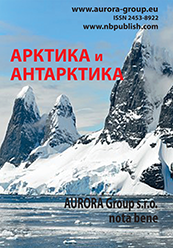Natural resources of the Arctic and Antarctica
Reference:
Parshin, A.V., Cherednichenko, A.E., Goryachev, I.N., Ikramov, Z.L., Trusova, V.V., Kurina, A.V., Kachor, O.L. (2025). Express assessment of air quality in several settlements of Eastern Eurasia based on the results of snow geochemical studies. Arctic and Antarctica, 4, 1–32. https://doi.org/10.7256/2453-8922.2025.4.74123
Abstract:
The features of atmospheric pollution in several settlements of various sizes, with significantly different levels of economic activity, located in different landscape and morphological conditions across a significant territory from the Ural Mountains to the Pacific Ocean have been studied. Students from the Siberian School of Geo-Sciences of Irkutsk National Research Technical University, coming from various cities, collected snowpack samples during the winter break, carried out sample preparation on-site, and then brought samples of snowmelt water and dry residue to the Institute's laboratories. The aim of detailed characterization of the atmospheric geochemical situation in each area was not set; the work is aimed at studying the possible ranges of technogenic and natural variability of concentrations of insoluble and soluble forms of pollutants in the air of industrial and background areas within the northeastern part of Eurasia, which is necessary for the development of a theoretical basis for ecological monitoring systems and assessment of the background state of natural and anthropogenic complexes within various projects of economic development of this vast and resource-rich part of Russia. Since the entire area considered is characterized by a long winter, the best way to integrally assess air quality is through studies of the snow cover. This work examined the chemical composition of the solid residue and snowmelt water and conducted a comparative assessment of median and limit concentrations among different sites. The authors consider snow geochemical surveying as the most promising method for studying background atmospheric states and assessing the impact of new and existing industrial facilities on it, which should become an integral part of the ecological support of economic activities in northern regions. However, the regulatory framework for such data is currently lacking, and new data on the snow geochemistry of various northern territories must be introduced into scientific circulation for its formation, as only on the basis of summarizing a significant volume of geochemical information can reliable and justified judgments be made regarding regional and local background issues, facts of its exceedances, and the significance of these exceedances. In addition to the direct data from various regions with different levels and types of load, among the important results are the factual assessments of the informativeness of various approaches to the methodology of snow geochemical studies.
Keywords:
Primorye, geochemical background, Irkutsk region, background state assessment, Chelyabinsk region, snow cover, heavy metals, environmental monitoring, snow geochemical survey, atmospheric pollution
Grounds of Cold Plains and Mountain Regions
Reference:
Tao, D., Brushkov, A.V., Safronov, . ., Cheverev , V.G., Alekseev , A.G., Gorbunova , .A., Mel'nikov , M.I., Kuvaev , V.A. (2025). Study of creep in frozen soils using various deformation models. Arctic and Antarctica, 4, 33–49. https://doi.org/10.7256/2453-8922.2025.4.74675
Abstract:
The subject of the study is the long-term creep of frozen clay soils at negative temperatures. Unlike most previous works based on short-term tests, this study implements an approach based on long-term (8–20 days) laboratory study of the samples using the uniaxial compression method. The objects of the research are kaolin clay, alluvial sandy loam, and clay loam collected in the Marre-Sale area and Moscow. The goal is to quantitatively determine the parameters of the deformation behavior of frozen soils and to select the most appropriate model for their description. The stages of creep and the influence of structure on the rate of deformation are considered. The obtained data are compared with the results of approximating four deformation models — strengthening, power, Burgers, and Nishihara — for subsequent application in predicting the stability of engineering structures in permafrost conditions. The methodology includes long-term laboratory tests of frozen clay soils using the uniaxial compression method at a temperature of −5 °C with the use of the "IVK Mechanics-Thermophysics" complex. Six samples of kaolin clay and one sample each of sandy loam and clay loam were used. The results are approximated using four mathematical creep models. The scientific novelty of the work lies in the comprehensive experimental study of the creep of frozen soils of various compositions over an extended period and the quantitative comparison of the effectiveness of mathematical models for describing the rheological behavior of these soils. For the first time, under prolonged tests at a constant load, the experimental data were approximated using four models, which allowed for identifying their advantages and limitations. It was established that the strengthening models and the power model most accurately describe the deformation behavior of all soil types (R² > 0.99). The Burgers model shows satisfactory results but underestimates deformations in the later stages. The Nishihara model requires modification for an adequate description of the accelerated stage. The results obtained have practical implications for assessing the reliability of foundations in the permafrost zone and for improving the rheological models of frozen soils.
Keywords:
engineering geocryology, load, creep model, uniaxial compression, deformation, experimental research, frozen clay soils, long-term creep, rheological properties, cryolithozone
 This work is licensed under a Creative Commons Attribution-NonCommercial 4.0 International License.
This work is licensed under a Creative Commons Attribution-NonCommercial 4.0 International License.











 © 1998 – 2025 Nota Bene. Publishing Technologies. NB-Media Ltd.
© 1998 – 2025 Nota Bene. Publishing Technologies. NB-Media Ltd.




